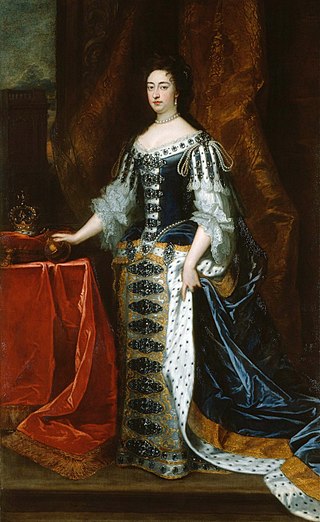
Mary II was Queen of England, Scotland, and Ireland, co-reigning with her husband, King William III and II, from 1689 until her death in 1694. She was also Princess of Orange following her marriage on 4 November 1677. Her joint reign with William over Britain is known as that of William and Mary.

Marie de' Medici was Queen of France and Navarre as the second wife of King Henry IV. Marie served as regent of France between 1610 and 1617 during the minority of her son Louis XIII. Her mandate as regent legally expired in 1614, when her son reached the age of majority, but she refused to resign and continued as regent until she was removed by a coup in 1617.
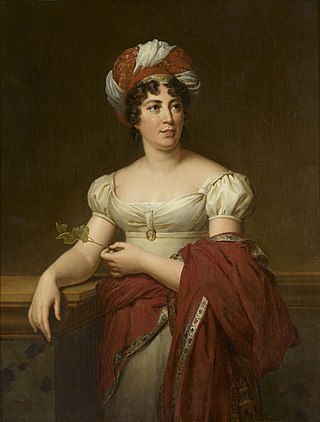
Anne Louise Germaine de Staël-Holstein, commonly known as Madame de Staël, was a prominent philosopher, woman of letters, and political theorist in both Parisian and Genevan intellectual circles. She was the daughter of banker and French finance minister Jacques Necker and Suzanne Curchod, a respected salon hostess. Throughout her life, she held a moderate stance during the tumultuous periods of the French Revolution and the Napoleonic era, persisting until the time of the French Restoration.

Louis Philippe II, Duke of Orléans, was a French Prince of the Blood who supported the French Revolution.
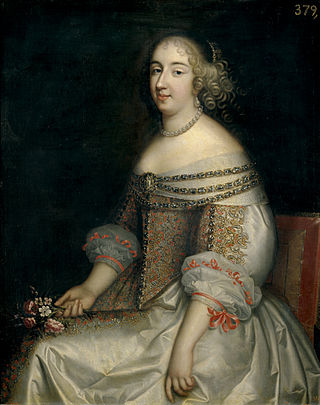
Anne Marie Louise d'Orléans, Duchess of Montpensier, known as La Grande Mademoiselle, was the only daughter of Gaston d'Orléans with his first wife, Marie de Bourbon, Duchess of Montpensier. One of the greatest heiresses in history, she died unmarried and childless, leaving her vast fortune to her cousin Philippe I, Duke of Orléans. After a string of proposals from various members of European ruling families, including Charles II of England, Afonso VI of Portugal, and Charles Emmanuel II of Savoy, she eventually fell in love with the courtier Antoine Nompar de Caumont and scandalised the court of France when she asked Louis XIV for permission to marry him, as such a union was viewed as a mésalliance. She is best remembered for her role in the Fronde, for bringing the composer Jean-Baptiste Lully to the king's court, and for her Mémoires.

Victoria Eugenie of Battenberg was Queen of Spain as the wife of King Alfonso XIII from their marriage on 31 May 1906 until 14 April 1931, when the Spanish Second Republic was proclaimed. A Hessian princess by birth, she was a member of the Battenberg family, a morganatic branch of the House of Hesse-Darmstadt. She was the youngest granddaughter of Queen Victoria and Prince Albert. Unlike other members of the Battenberg family, who were accorded the lower rank of Serene Highness, Victoria Eugenie was born with the rank of Highness due to a Royal Warrant issued in 1886 by Queen Victoria.

Louise Marie Adélaïde Eugénie d'Orléans was a French princess, one of the daughters of Philippe d'Orléans, known as Philippe Égalité during the French Revolution, and Louise Marie Adélaïde de Bourbon. She was titled Mademoiselle de Chartres at birth, Mademoiselle d'Orléans at the death of her older twin sister in 1782, Mademoiselle (1783–1812), Madame Adélaïde (1830). As a member of the reigning House of Bourbon, she was a princesse du sang.

Mary, Princess Royal, was a British princess, a member of the House of Stuart, and by marriage Princess of Orange and Countess of Nassau. She acted as regent for her minor son from 1651 to 1660. She was the first holder of the title Princess Royal.
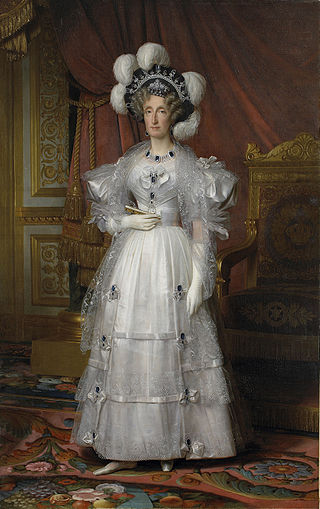
Maria Amalia Teresa of Naples and Sicily was Queen of the French by marriage to Louis Philippe I, King of the French. She was the last queen of France.

Louis Henri Joseph de Bourbon was the Prince of Condé from 1818 to his death. He was the brother-in-law of Philippe Égalité and nephew of Victoire de Rohan.
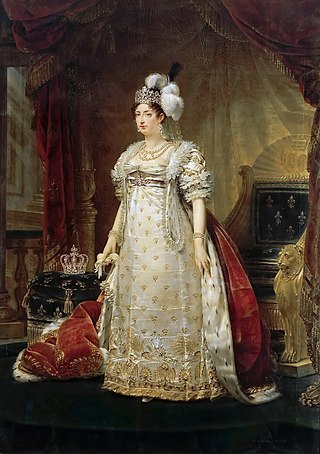
Marie-Thérèse Charlotte was the eldest child of King Louis XVI and Queen Marie Antoinette of France, and their only child to reach adulthood. In 1799 she married her cousin Louis Antoine, Duke of Angoulême, the eldest son of Charles, Count of Artois, henceforth becoming the Duchess of Angoulême. She was briefly Queen of France in 1830.
Marion Kirk Buthlay CVO was a Scottish educator and governess to Princess Margaret and Princess Elizabeth. Known then by her maiden name, Elizabeth and Margaret affectionately called her Crawfie. Crawford worked for the Royal Family from 1933 to 1949. Upon her departure, she agreed to author The Little Princesses, a book which told the story of her time with the family. Though given tentative approval by the royal family to publish anonymously, Crawford was completely ostracised by them after her writing appeared under her name; she left Nottingham Cottage, her grace and favour house, and no member of the family ever spoke to her again.
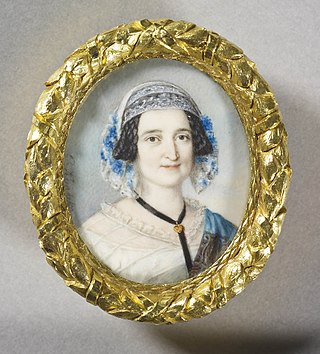
Johanna Clara Louise, Baroness von Lehzen was the governess and later companion to Queen Victoria of the United Kingdom.

Margaret of Savoy was the last Habsburg Vicereine of Portugal from 1634 to 1640. In Portuguese she is known as Duquesa de Mântua, being by marriage the Duchess of Mantua and Montferrat. She was also regent of Montferrat during the minority of her daughter from 1612.
The following is a list of the major publications of Johann Wolfgang von Goethe (1749–1832). 142 volumes comprise the entirety of his literary output, ranging from the poetical to the philosophical, including 50 volumes of correspondence.
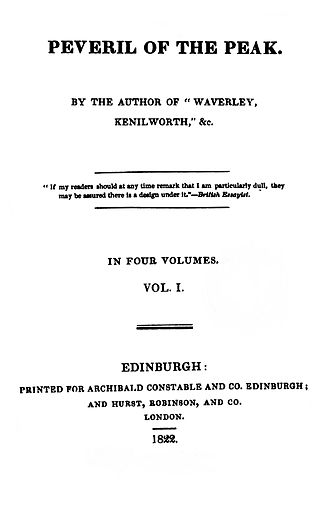
Peveril of the Peak (1823) is the longest novel by Sir Walter Scott. Along with Ivanhoe, Kenilworth, and Woodstock this is one of the English novels in the Waverley novels series, with the main action taking place around 1678 in the Peak District, the Isle of Man, and London, and centring on the Popish Plot.

Louise Marie Thérèse d'Artois was a duchess and later a regent of Parma. She was the eldest daughter of Charles Ferdinand, Duke of Berry, younger son of King Charles X of France and Princess Caroline of Naples and Sicily. She served as regent of Parma during the minority of her son from 1854 until 1859.
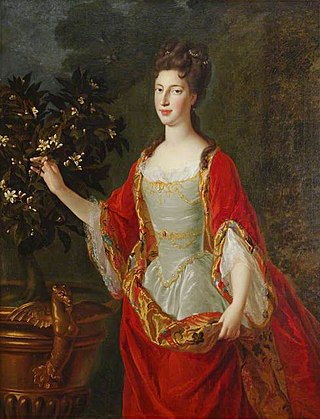
Louisa Maria Teresa Stuart, known to Jacobites as The Princess Royal, was the last child of James II and VII, the deposed king of England, Scotland and Ireland, by his second wife Mary of Modena. Like her brother James Francis Edward Stuart, Louisa Maria was a Roman Catholic, which, under the Act of Settlement 1701, debarred them both from succession to the British throne after the death of their Protestant half-sister Anne, Queen of Great Britain.
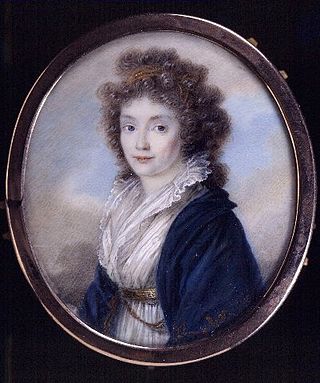
Hedvig Ulrika De la Gardie, was a Swedish lady-in-waiting. She was married to Gustaf Mauritz Armfelt. She was the head governess of the Swedish royal children in 1799–1803.

Princess Eugenia Maximilianovna of Leuchtenberg was a daughter of Maximilian de Beauharnais, 3rd Duke of Leuchtenberg and his wife Grand Duchess Maria Nikolaevna of Russia. Although she was a member of the French House of Beauharnais, she was born and raised in her mother's native country, Russia.


















